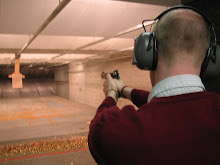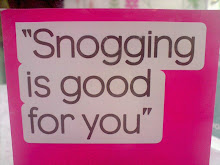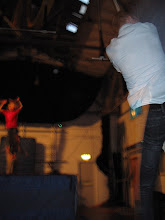Modern art is rubbish. Not all of it, just a lot of it. I realise that I'm sweeping a broad brush in making that infuriatingly general statement but after watching last night's BBC show School of Saatchi, I can't help it. After so much grey, fudging, blurring, smoke and mirrors twaddle from the various wannabe Damien Hirsts and Tracey Emins, I feel the need to rail in simple black and white terms.
For those of you that have missed out on this gem of terrestrial entertainment, let me fill you in. Charles Saatchi, marketing mogul and self-styled Don of the modern art world, has hand-picked half a dozen hopefuls straight out of the pretentiously cool Hoxton set. In The Apprentice meets Art Attack, the said sextet must impress Saatchi and his team of expert confidantes through a series of challenges. One budding Jeff Koons will ultimately have the honour of showcasing his or her talent at the world famous Hermitage in St Petersburg as part of the Newspeak: British Art Now exhibition.
Now, to my mind and eyes, a large number of modern artists are in fact con artists. Hirst has no fewer than three exhibitions running in London. One of those, No Love Lost, at the Wallace Collection, shows the shark pickler to be an average painter at best. And of course Emin is most famous for passing off a dirty bed as a modern masterpiece.
I am reminded of an incident at Tate Britain's Art and The Sixties exhibition in the summer of 2004. Gustav Metzger, the "inventor" of auto-destructive art, had one of his sculptures thrown out with the rubbish. Well, hardly surprising when the piece itself was actually a plastic sack full of waste paper. It was quickly replaced with another polythene bin liner holding a new batch of waste and no one was any the wiser for a while. As auto-destructive art is defined as "paintings, sculptures and constructions having a finite existence - after which they will be destroyed," I reckon the sculpture's disposal was merely a fulfillment of its being. But can you imagine Rodin chipping the last piece of marble from The Thinker, looking it up and down and then taking a sledgehammer to it?
Of course, what I'm really objecting to is conceptual art and the "if you don't like it, it's because you just don't get it" mantra of its acolytes. This is where School of Saatchi is brilliant. From Saad Qureshi with his 2,000 stacked chipati breads to fellow Slade student Eugenie Scrase and her DIY-gone-wrong, the show has hilariously exposed several of the artists as cynically conceited blag merchants, mickey-taking charlatans or simply spaced-out fantastists with little demonstrable talent.
In last night's show, the artists were taken to Sudeley Castle in the Cotswolds, home of Lady Ashcombe, the last resting place of Katherine Parr (Henry VIII's sixth wife) and a treasure trove of art down the ages. Cue Qureshi and his bread, baked lovingly by his mother in the family's Oxford semi and transported to Sudeley's historic library.
"This work is not about food, it's about the love we share and we're going to give it on to Lady Ashcombe and her family," cooed Qureshi, who was on the verge of a hissy fit when renowned artist Mat Collison asked, "isn't it a bit...lame?"
Qureshi fully embraced the performance aspect of his piece by mailing a chipati to her ladyship prior to the big unveiling, for which, by the way, he took along his entire bemused family. After laying down his mother's old rug in place of some or other renaissance carpet, Qureshi slapped down his chipatis in piles and proceeded to tell us how every individual wheel of unleavened had a story to tell.
"Each chipati talks of the action we did at home."
Now call me cynical, but at no time did Qureshi reference his work to the library, despite his remit to produce a piece that connected with the room's history. Well, that was until fellow hopeful Suki Chan ruffled his feathers by trying to scatter black books across the floor. In objecting to Chan's arrangement, the chipatis embraced a new message. They were in fact not just the embodiment of love, the bread actually represented the pages of the books in the library. Beautiful bull!
But the best tosh came from Scrase who had constructed a bizarre motorized clothes line above a radiator in one of the castle's bedrooms. Powered by what looked to be a Black & Decker drill, a tassle taken from one of the curtains whirred around and around the line. She said she liked the idea of movement and was inspired by The Generation Game with its conveyer belt stuffed with prizes. Apparently, Sudeley Castle's treasures reminded her of Bruce Forsyth and Saturday night gameshow goodies. Shame there wasn't a cuddly toy in the room!
Scrase mimicked Qureshi in giving the distinct impression that she was making it all up as she went along. After a bit of trouble with her drill speed, she suddenly came up with a new and inspired take on her work.
"I had a bit of a change of heart" she revealed, gazing intently at the motionless tassle. "I decided I always liked the potential of movement but never liked the actual movement, and so I was actually thinking, I might keep it static. It's even more powerful when it's not working. They'll imagine it go round so there's a bit of effort coming from the viewer's point of view. It makes them think about...things."
In slagging off the subjects of the BBCs attempt at higher-brow reality TV, I don't want to sound as though I'm against all forms of what we generally and incorrectly lump together under the umbrella of modern art. For every crass Koons there is a wonderful Warhol; Hirst's horrors are counterbalanced by Dali's brilliance; Rothko's mundanity takes a back seat to a vibrant Pollock. And of course, the great caveat rings loud and true - it's all subjective.
Indeed, one of the Saatchi candidates, Matt Clark, seems to have potential. There is certainly merit to his work.
But when all is said and done, conceptual art can so often be fraudulent art. When Marcel Duchamp started the "movement" in 1917 with his signed urinal entitled Fountain, he was making a point. He was making an original statement that did not need repeating. Too many artists are simply revisiting Duchamp. Many lose sight of art as a thing of recognisable beauty in their increasingly blinkered quest for acceptance from the art elite. In a warped way, and despite artists apparently seeming to push boundaries, true originality is actually swamped beneath an unconscious adherence to what is deemed in vogue. A swathe of artists appear content to blag and bull their way to acceptance from a clique so wrapped up in a pretence of superior cultural wisdom that it can no longer distinguish the Fountain from the bedpan.




